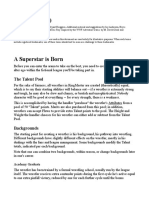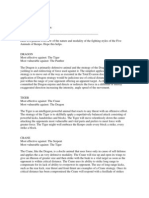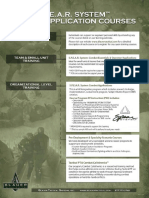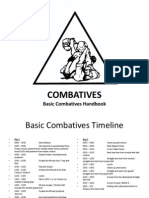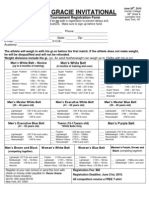Shredder Seminar Recap
Shredder Seminar Recap
Uploaded by
Daren WilliamsCopyright:
Available Formats
Shredder Seminar Recap
Shredder Seminar Recap
Uploaded by
Daren WilliamsOriginal Description:
Copyright
Available Formats
Share this document
Did you find this document useful?
Is this content inappropriate?
Copyright:
Available Formats
Shredder Seminar Recap
Shredder Seminar Recap
Uploaded by
Daren WilliamsCopyright:
Available Formats
Shredder Seminar Recap
Brian B.
Posted 3/25/12 3:06 PM Link to discussion
Brian-B.
Group Organizer
Philadelphia, PA
Post #: 32
Send an Email Post a Greeting
Here's my notes from our "Shredder Seminar" on Sat., Mar. 24th, 2012. This was a 90-minute self-
defense seminar for men & women of all skill levels. The purpose was to introduce participants to one of
the most effective unarmed self-defense tactics for close quarters combat - the "Shredder". Developed
by Canadian self-defense trainer Richard Dimitri, the Shredder is a rapid barrage of short range strikes,
rakes, rips, gouges, and neck cranks that completely overwhelms an assailant. It's advantage is that it
can be learned in a short time and can offer a powerful self-defense tactic to even smaller, weaker or
less trained individuals. It will often be difficult for a smaller person to knockout a larger opponent with
punches & kicks, throw them, joint lock them, or choke them out. However, a smaller person can always
injure a larger opponent with attacks to the soft tissues of the face & neck - i.e. eye gouge, trachea
crush, jugular pinch, ear rip, fishhook, face rake, neck bite, etc.
To see what the Shredder looks like applied full speed, check out this video clip:
Shredder Demo: http://www.youtube.co...-
The man demonstrating the Shredder in this clip is the concept's creator, Richard Dimitri. As you can
see, he can safely demonstrate it by not fully applying the rakes, rips & gouges to his partner's face.
Essentially, he is just simulating these deadly tactics by vigorously rubbing his partner's face and twisting
his partner's head in different directions. This low-force application of the Shredder is referred to as
"face wiping" or "face washing".
For beginners, it's necessary to slow the action down and occasionally "freeze frame" the situation so
they can understand which of their body weapons are closest to the targets on their attacker's body.
This is referred to as "tool & target development". This is well illustrated in this second clip, which works
from an initial start where both attacker & defender are standing with their palms out & touching -
something known as the "Mirror Drill". As you can see from the clip, slowing the action down in the
initial phase of training allows you to easily determine what opening your partner is presenting and how
you could attack them:
- Shredder Mirror Drill: http://www.youtube.co...-
When you first start practicing the Shredder, you probably won't be able to think of the wide range of
attacks Richard Dimitri demonstrated in that clip. You'll most likely concentrate on just wiping your
training partner's face rapidly and twisting their neck, and that's really the most important way to start.
The face wiping is very disorienting, and the neck twists break their balance and often make your
partner bend over or fall to the floor. Once you've put them on the defensive, you're better able to see
the openings to insert strikes like headbutts, elbows, hammerfists, palm strikes, knees, foot stomps, etc.
And since you've got control of their head and you've put them off-balance with the neck twists, you can
also take this opportunity to bounce their head off any nearby hard object (a brick wall, table, car, street
sign, window pane, etc.) or toss them down so their head hits the ground quite hard.
One of the most important parts of the Shredder is "trapping" or "anchoring" - i.e. you must get close to
your opponent and get a hold of them so they can't easily disengage after your first couple attacks. If
they do, they can recover and then renew their attack. You must inflict enough damage to them that
they are unable to continue their attack, or at least enough to cause them to fall to the ground which
will allow you the opportunity to escape & run away. Typically, trapping them is done by either (1)
grabbing the back of their head with one hand (known in wrestling as a "neck tie"), (2) wrapping your
arm OVER their upper arm (known as an "overhook"), or (3) wrapping your arm around their head/face
(like a front, side or rear headlock). It can also be done by (4) wrapping your arm UNDER their upper arm
& grabbing their shoulder (known as an "underhook") or (5) wrapping around their waist & grabbing
their ribs or lat muscle(known as a "seatbelt"), although this makes it harder for the trapping hand to
transition into a facial attack. The trapping principle is illustrated in the following clip:
- Importance of Trapping: http://www.youtube.co...-
Initially, we practiced using the Shredder off the "passive stance" - it's similar to a standard kickboxing
stance with the hands held up, but they're open, palms out. This gives the impression, "Hey, calm down.
I don't want to fight," and it allows you a chance to talk the person down. This is a good stance to use in
any real-life altercation that you fear may turn violent. If you can't defuse the situation, having your
hands up allows you to block your opponent's attempt to strike your head or grab you, and it also allows
you to quickly counterattack them. Quite often, if an aggressive person feels they can intimidate you,
they'll get very close, almost face-to-face. If you have your hands up, you can slam a palm strike into
their face and start applying the Shredder before they have time to react.
This is how we initially practiced using the Shredder:
(1) you have your hands up in a passive stance,
(2) the opponent gets up in your face & makes an aggressive or threatening motion,
(3) you simultaneously wrap their arm to trap them & palm strike their chin, then rake their face,
(4) you unwrap your other arm from theirs and use it to now wrap their head & grab their face,
(5) you begin to simulate a series of rakes, rips & gouges to their neck & face with your hands using a
"face wiping" motion.
For the "face wiping" motion - which simulates both the initial palm strike and the subsequent rake of
the fingernails across the opponent's face - our hand can be oriented in one of five basic ways:
(1) Palm Striking Sideways from the Left, Then Raking Back Right-to-Left
(2) Palm Striking Straight Up Under the Chin or Nose, Then Raking Down
(3) Palm Striking Sideways from the Right, Then Raking Back Left-to-Right
(4) Reaching Over the Opponent's Head (used if they're bent over), Then Raking Up
(5) Wrapping the Opponent's Head, Then Raking From the Far Side
The rake of the fingers across the face also usually twists the opponent's neck, which helps to break
their balance and forces them to turn.
An important part of the Shredder is getting behind your opponent, a position known as "chest-to-
back". This is very effective because it drastically limits your opponent's ability to counterattack you. It's
fairly easy to punch & grab someone standing right in front of you, but it's much more difficult to hit or
grab someone behind you. Neck twists usually force the opponent to turn and give you their back,
although wrestling moves like the "arm drag" and "duck under" can be used to get behind as well. The
chest-to-back principle is shown in the following clip:
Getting Chest-to-Back: http://www.youtube.co...-
Edited by Brian B. on Mar 29, 2012 8:52 AM
Brian B.
Posted 3/25/12 3:58 PM Link to reply
Brian-B.
Group Organizer
Philadelphia, PA
Post #: 33
Send an Email Post a Greeting
ENTERING WITH THE PALM BLAST
Sometimes, your opponent may not be close enough for you to immediately enter the Shredder, and so
for these cases we practiced "entering" - a.k.a. "closing" or "bridging the gap" - with a rapid flurry of
strikes. For those familiar with Wing Chun or Jeet Kune Do (JKD), the technique was similar to the
"straight blast" demonstrated in this clip:
- Straight Blast Demo: http://www.youtube.co...-
We trained this entry using the Muay Thai pads as the target, just like we train the jab/cross combo in
kickboxing. However, we used a variation known as the "Palm Blast", where you hit with the palms of
the hands rather than closed fists. This is better from a street self-defense perspective, since you avoid
the risk of breaking your knuckles and you increase the likelihood of poking your opponent in the eyes
with your fingers which will make them flinch. Once the students forced their opponent to back pedal
with their palm blast, they wrapped their opponent's arm & got their other hand in the opponent's face,
and then began to shred as before.
Once the students managed to successfully enter with the palm blast & start shredding, we practiced
having the pad-holding partner try to get away by pushing on their shredding partner with the pads. This
forced the shredding partner to stay close and continue to trap them by wrapping the head or arm so
they couldn't disengage and recover enough to attack them back.
ENTERING WITH JKD HAND TRAPS
One common way that an opponent may try to prevent you from entering into close range is simply
raising their arms to shield themselves from the palm blast and just push you away from them when you
try to get close enough to shred. To deal with this, we practiced using two different JKD-style hand
trapping entries to get past the opponent's raised arms. These entries were the same-side "slap hit"
(known in JKD as a pak sao) and the cross-side "pull hit" (known in JKD as a lop sau). The goal was simply
to knock the opponent's raised arm aside and simultaneously drive the other hand into their face, and
then initiate the Shredder. (For an idea of how the JKD hand traps clear the opponent's forearms out of
the way and create an opening for your initial strike, watch this clip: http://www.youtube.co...-)
DEALING WITH ATTEMPTS TO DISENGAGE
In cases where the opponent was directly in front of you, we found it wasn't uncommon for the
opponent to try to disengage by bending over at the waist. This allows you to put them in a position
similar to a front headlock. However, the object should not be to simply headlock them and hold on.
This wouldn't work against a larger, stronger adversary, and would leave you open to having your legs
grabbed or (for men) being struck in the groin. Instead, you keep your hands in their face and continue
to shred them. I demonstrated how you can use your hands to twist their head to the side & then pull
up on their neck, which produces a powerful "neck crank" - known as a "front face lock" - that is very
painful and can damage your opponent's cervical spine. (Here's a clip showing how to apply the front
face lock: http://www.youtube.co...-)
Another common way the pad-holding partner would try to disengage from the Shredder is by turning
around and then bending over. If you're focused on keeping your hands in their face, you may
accidentally end up hopping on the person's back. This would leave you vulnerable of being thrown to
the ground. To prevent this, we found that it was often better to move back around to your partner's
side so you could continue to keep your hands in their face. This way, you could still trap & shred them,
often getting them in a position similar to a side headlock.
In addition to turning away or bending over, a very common way an opponent will try to stop your
shredding is by grabbing your hands and pulling them off their face. The best way to counter this is to
fingerlock them as soon as you see their hands come up, but BEFORE they grab your wrists. The best
way to break a person's fingers is to only grab one or two of them, not three or four fingers and not the
thumb. When you grab too many fingers they can resist having the fingers bent back, and the thumb is
fairly strong and hard to break. Of course, sometimes you might not be able to get the fingerlock in time
and the opponent will grab one or both of your wrists, controlling you and temporarily stopping the
Shredder.
DEALING WITH THE DOUBLE WRIST GRAB
Lastly, we covered how to use different "body weapons" (headbutt, knee, kick, bite) if an opponent
grabs both your wrists, making them let go in order to (re-)initiate the Shredder. If you always assume
you need your hands free to attack, you might freak out in a situation where someone grabbed both
your wrists. But as I showed the students, you can make the opponent let go by kneeing or snap kicking
their groin, stomp kicking their shin or instep, headbutting their face, biting their face/neck/shoulder, or
biting into their fingers or wrist. Once your opponent lets go with at least one hand, you can then begin
to rake, rip & gouge with it and flow into the Shredder.
CONCLUSION
This seminar was a good introduction to the Shredder concept, and within a little over 90 minutes the
students were all able to grasp the concept and apply it on a moderately resisting partner. I plan on
running several more Shredder seminars over the summer, and I urge anyone interested to come and
check them out. Each seminar will review the basics of how to employ the Shredder, but it will also
introduce some new drills and it will cover some different scenarios like using the Shredder against an
armed opponent, against multiple opponents, or while wrestling on the ground. This means that it's still
useful to attend another Shredder seminar even if you've been to one of them already.
NOTE: I'm not certified by nor affiliated with the Shredder's creator, Richard Dimitri, although I've
attended one of his training seminars, participated for several years on his online forum
(http://senshido.savi....-, and own several of his instructional DVDs. He's a great instructor and his
materials are top notch. If you're interested in learning more, I can definitely recommend purchasing
any of his DVDS - especially the Shredder Package: http://www.senshido.c...-
Edited by Brian B. on Mar 29, 2012 9:07 AM
http://www.meetup.com/The-Philly-Ronins-Fight-
Club/messages/boards/thread/21750362http://www.protectselfdefenceshop.com/Self-Defence-
Products-Shop(2132622).htm
You might also like
- El Ojo Místico - Victor StoichitaDocument204 pagesEl Ojo Místico - Victor StoichitaSophia Battaglini100% (4)
- 1 TJDDocument19 pages1 TJDjbsimha3629No ratings yet
- Marietta Police Department BJJ Training Program DataDocument1 pageMarietta Police Department BJJ Training Program DataMyles Yang100% (1)
- Street Focus Jujitsu HandbookDocument46 pagesStreet Focus Jujitsu HandbookRon Collins100% (2)
- Mas Oyama Guide PDFDocument7 pagesMas Oyama Guide PDFTokatuu91% (11)
- American CombativesDocument101 pagesAmerican CombativesDaren Williams100% (24)
- Ringmaster3 0Document93 pagesRingmaster3 0duce_bishopNo ratings yet
- WWE SVR 2011 ps2 PAC LISTDocument3 pagesWWE SVR 2011 ps2 PAC LISTEduard Bernea50% (4)
- Here DimitriDocument17 pagesHere Dimitridiamond68100% (1)
- Knife Defense With Empty HandDocument19 pagesKnife Defense With Empty HandGuroGaniNo ratings yet
- Hapkido Tech To NeutralizDocument0 pagesHapkido Tech To NeutraliznitrofrogNo ratings yet
- Kickboxing: Short Range Fighting: From Initiation To Knockout: Kickboxing: From Initiation To Knockout, #6From EverandKickboxing: Short Range Fighting: From Initiation To Knockout: Kickboxing: From Initiation To Knockout, #6No ratings yet
- Background Information On Kapap, Gracie Combatives and CatchDocument13 pagesBackground Information On Kapap, Gracie Combatives and CatchTeo Yew Chye100% (2)
- Cold Weather Operations Manual: Northern Warfare Training CenterDocument169 pagesCold Weather Operations Manual: Northern Warfare Training CenterTyler Jackson100% (1)
- Book Previous Chapter: The Short VersionDocument49 pagesBook Previous Chapter: The Short VersionIsagani AbonNo ratings yet
- The 101st Recondo School Curriculum During The Pre Vietnam EraDocument2 pagesThe 101st Recondo School Curriculum During The Pre Vietnam EraJerry Connersนักกระโดดร่มNo ratings yet
- Awareness and Kettlebell TrainingDocument6 pagesAwareness and Kettlebell TrainingbionicrasNo ratings yet
- Gang Fit Part 3 by Mark BakerDocument68 pagesGang Fit Part 3 by Mark BakerMiguel Costa100% (1)
- Basic Combatives Instructor Course (Level III) Comprehensive Exam PDFDocument2 pagesBasic Combatives Instructor Course (Level III) Comprehensive Exam PDFJanne FredrikNo ratings yet
- LINE (Combat System) - Wikipedia PDFDocument4 pagesLINE (Combat System) - Wikipedia PDFChuckNo ratings yet
- Chun Tu Moo SoolDocument10 pagesChun Tu Moo SoolctmsmasterNo ratings yet
- Five Animals of Kenpo Mnkenpokarate ComDocument2 pagesFive Animals of Kenpo Mnkenpokarate ComWilliam E. Hawkins Jr.No ratings yet
- Pekiti-Tirsia Kali System: Foundation Footwork 1-8Document3 pagesPekiti-Tirsia Kali System: Foundation Footwork 1-8Kin Fung HoNo ratings yet
- Kan Shu Kenpo Test PackagePurple Belt Through Brown Belt (99) - TestingDocument1 pageKan Shu Kenpo Test PackagePurple Belt Through Brown Belt (99) - TestingJason SpottsNo ratings yet
- D.G.C.F.S Iusse33 Reality Based Combat 2/2013Document22 pagesD.G.C.F.S Iusse33 Reality Based Combat 2/2013Mr.Traylor100% (1)
- H2HDocument5 pagesH2HmarcitectNo ratings yet
- Baki Workout Routine Train Like A Mixed Martial Arts MasterDocument1 pageBaki Workout Routine Train Like A Mixed Martial Arts Masterseth hansmanNo ratings yet
- D.G.C.F.S Reality Based Martial Arts Iusse13Document14 pagesD.G.C.F.S Reality Based Martial Arts Iusse13Mr.Traylor100% (3)
- Traditional TrainingDocument8 pagesTraditional TrainingChetanya MundachaliNo ratings yet
- AKI Knife DefenseDocument4 pagesAKI Knife DefenseGuroGaniNo ratings yet
- Krav Maga RequirementsDocument5 pagesKrav Maga RequirementsFaustNo ratings yet
- Basic Combatives Instructor Course (Level III) Timeline PDFDocument29 pagesBasic Combatives Instructor Course (Level III) Timeline PDFJanne FredrikNo ratings yet
- Special Issue FMA SchoolsDocument43 pagesSpecial Issue FMA Schoolslaukune100% (1)
- KM Instructor Course Phase 1aDocument22 pagesKM Instructor Course Phase 1anozza_1No ratings yet
- Urban Kobudo 6th Kyu: Hanbo (90 - 100 CM) Tanbo (70 CM), Tanjo (40 - 50 CM)Document4 pagesUrban Kobudo 6th Kyu: Hanbo (90 - 100 CM) Tanbo (70 CM), Tanjo (40 - 50 CM)Jean Paul SikkarNo ratings yet
- SPEAR Combat Application CoursesDocument4 pagesSPEAR Combat Application CoursesJPC RADARNo ratings yet
- Houston Reality Based Martial Arts & CombativesDocument26 pagesHouston Reality Based Martial Arts & CombativesMr.TraylorNo ratings yet
- Americana To Triangle From MountDocument60 pagesAmericana To Triangle From MountYusrohDarmantoroNo ratings yet
- Sword and Pen: Persistence Is A Critical Key To Training SuccessDocument21 pagesSword and Pen: Persistence Is A Critical Key To Training Successsandlied100% (2)
- Full Mission ProfileDocument5 pagesFull Mission ProfileJesseKent100% (1)
- PDF Training Brief #31 - Repetition and AttitudeDocument10 pagesPDF Training Brief #31 - Repetition and AttitudeDave Whammer100% (1)
- Post and Pre Training Definition and Their ActivitiesDocument4 pagesPost and Pre Training Definition and Their ActivitiesAASNo ratings yet
- MCMAP Belt SystemDocument4 pagesMCMAP Belt SystemFaustNo ratings yet
- 35 Stick Essentials - Layout 1Document5 pages35 Stick Essentials - Layout 1Dexter James100% (1)
- 2006 Australian Tour: Seminar Details Registration FormDocument2 pages2006 Australian Tour: Seminar Details Registration FormArunMartialArtsNo ratings yet
- Physical Conditioning For Combat Sports Book ReviewDocument5 pagesPhysical Conditioning For Combat Sports Book ReviewMateuszNo ratings yet
- Raven Newsletter Issue SixDocument94 pagesRaven Newsletter Issue Sixdiamond68100% (5)
- Close Combat - Notes For Instructors (Exerpt)Document1 pageClose Combat - Notes For Instructors (Exerpt)adrianodsbNo ratings yet
- UC Solo Training WOD OneDocument4 pagesUC Solo Training WOD OneMelynda Wilson100% (1)
- Kan Shu Kenpo Techniques/Forms ListDocument1 pageKan Shu Kenpo Techniques/Forms ListJason SpottsNo ratings yet
- CapoeiraDocument21 pagesCapoeiraaleksa1292No ratings yet
- (MAC) Basic Combat Ives Hand BookDocument68 pages(MAC) Basic Combat Ives Hand BookSamurai_Chef100% (3)
- The Classic Strikes by Dennis MartinDocument22 pagesThe Classic Strikes by Dennis Martincqb123100% (1)
- Combatives Overview PDFDocument6 pagesCombatives Overview PDFBrad Tennent0% (1)
- Sensitive Areas BookDocument14 pagesSensitive Areas Bookdiamond68No ratings yet
- Arm Drag Summary ComicDocument24 pagesArm Drag Summary ComiclutherNo ratings yet
- Junior Curriculum Binder PDFDocument39 pagesJunior Curriculum Binder PDFDmt AlvarezNo ratings yet
- Practitioner 3 PDFDocument3 pagesPractitioner 3 PDFkaarkula100% (1)
- From Medieval Manuscript to Modern Practice: The Wrestling Techniques of Fiore dei Liberi: From Medieval Manuscript to Modern Practice, #2From EverandFrom Medieval Manuscript to Modern Practice: The Wrestling Techniques of Fiore dei Liberi: From Medieval Manuscript to Modern Practice, #2No ratings yet
- 8 Ways to Be Professional and Ethical in the Martial Arts: The Power Trip: How to Survive and Thrive in the Dojo, #2From Everand8 Ways to Be Professional and Ethical in the Martial Arts: The Power Trip: How to Survive and Thrive in the Dojo, #2No ratings yet
- Work Defense Oct 2005Document625 pagesWork Defense Oct 2005palosot100% (1)
- Wado Ryu CommentaryDocument17 pagesWado Ryu CommentaryDaren WilliamsNo ratings yet
- Inside The Fighting MeasureDocument23 pagesInside The Fighting MeasureMike Blesch100% (7)
- Bob Fitzsimmons Physical Culture and Self-Defence 1901Document184 pagesBob Fitzsimmons Physical Culture and Self-Defence 1901cmonBULLSHITNo ratings yet
- High Performance SparringDocument27 pagesHigh Performance SparringDaren Williams100% (2)
- Inside The Fighting MeasureDocument23 pagesInside The Fighting MeasureMike Blesch100% (7)
- Joe Lewis GuideDocument8 pagesJoe Lewis GuideDaren Williams100% (2)
- Mma To CQC GuideDocument7 pagesMma To CQC GuideDaren Williams100% (1)
- Street Fighting - America's Martial Art - George CarpenterDocument60 pagesStreet Fighting - America's Martial Art - George Carpentershaqtim100% (11)
- US Army - Ranger Handbook (2006 Edition) SH 21-76Document327 pagesUS Army - Ranger Handbook (2006 Edition) SH 21-76Jimmy Slick Candlestick BondNo ratings yet
- Practice Test 4 Use of English I. Choose The Correct Answer (A, B, C or D) That Best Completes Each SentenceDocument7 pagesPractice Test 4 Use of English I. Choose The Correct Answer (A, B, C or D) That Best Completes Each SentenceddannguyenbaoNo ratings yet
- WWE SS Rulebook V1 2 WebDocument16 pagesWWE SS Rulebook V1 2 WebSerkan KarasanNo ratings yet
- Eric Bischoff Book PDFDocument2 pagesEric Bischoff Book PDFJenniferNo ratings yet
- High JumpDocument6 pagesHigh JumpNaresh KumarNo ratings yet
- Thompson, Geoff - Ground Fighting - Pins The BedrockDocument89 pagesThompson, Geoff - Ground Fighting - Pins The BedrockDave100% (2)
- Invitational FormDocument2 pagesInvitational Formopenid_rQci7odxNo ratings yet
- Arnis FinalDocument60 pagesArnis FinalJoshua Verzosa Palconit33% (6)
- Choice Board - Tic Tac ToeDocument1 pageChoice Board - Tic Tac Toeapi-449499651No ratings yet
- Train To Win - Martin Rooney PDFDocument88 pagesTrain To Win - Martin Rooney PDFAnonymous p7oYQEkXMdNo ratings yet
- The AFC Combat League: Rules For CompetitionDocument4 pagesThe AFC Combat League: Rules For Competitiondondavis77No ratings yet
- Ancient Indian SportsDocument43 pagesAncient Indian Sportsgagansharma8467% (3)
- Strength and Conditioning Considerations For Mixed Martial ArtsDocument12 pagesStrength and Conditioning Considerations For Mixed Martial ArtsmoaNo ratings yet
- Tummy Time Cheat Sheet Tips Tricks - Fit Family Physical TherapyDocument1 pageTummy Time Cheat Sheet Tips Tricks - Fit Family Physical TherapyLolyta Rosmelina NaibahoNo ratings yet
- History of Arnis EssayDocument2 pagesHistory of Arnis EssayNatss VillanuevaNo ratings yet
- Real Steel ScreenplayDocument52 pagesReal Steel ScreenplayVitor BrunoNo ratings yet
- International Wrestling Rules: Greco-Roman Wrestling Freestyle Wrestling Women'S WrestlingDocument45 pagesInternational Wrestling Rules: Greco-Roman Wrestling Freestyle Wrestling Women'S WrestlingRichard ChaviraNo ratings yet
- Geeta PhogatDocument3 pagesGeeta PhogatJayaraj BalachandranNo ratings yet
- Aberrant - XWFDocument26 pagesAberrant - XWFlordhavok33100% (4)
- Bankruptcy! FMW by Shoichi Arai, Emu Eaglestone (Translator)Document71 pagesBankruptcy! FMW by Shoichi Arai, Emu Eaglestone (Translator)Salih ArandıNo ratings yet
- Result 2016Document384 pagesResult 2016Apple AdsNo ratings yet
- Wado Ryu Kata - Pinan Sandan KataDocument2 pagesWado Ryu Kata - Pinan Sandan KatagypsylanternNo ratings yet
- PDFDocument162 pagesPDFRobert Miles100% (1)
- A Special Offer For You Awaits Inside.... : 7 Must Know Escapes For Smaller Grapplers Dan FaggellaDocument18 pagesA Special Offer For You Awaits Inside.... : 7 Must Know Escapes For Smaller Grapplers Dan FaggellaВидади ГаджиевNo ratings yet
- Barbarian Subclass - Herculean Path, RevisedDocument3 pagesBarbarian Subclass - Herculean Path, Revisedsuperdaniel 87No ratings yet
- 2ksmkt Wwe2k17 PC Online Manual v3Document13 pages2ksmkt Wwe2k17 PC Online Manual v3adhiNo ratings yet
- Ninja ScrollDocument63 pagesNinja ScrollAbdullah AL Masud0% (1)
- Commonwealth Games 2018 Winners ListDocument6 pagesCommonwealth Games 2018 Winners ListSaikumarNo ratings yet






